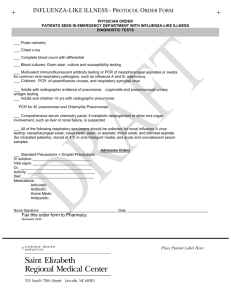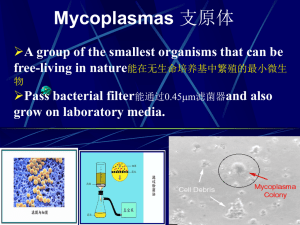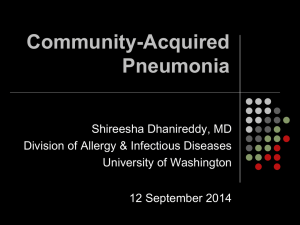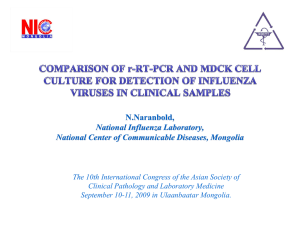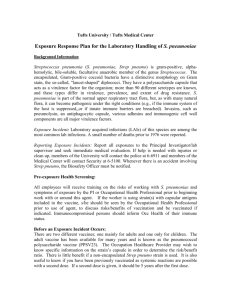ABSTRACT
advertisement
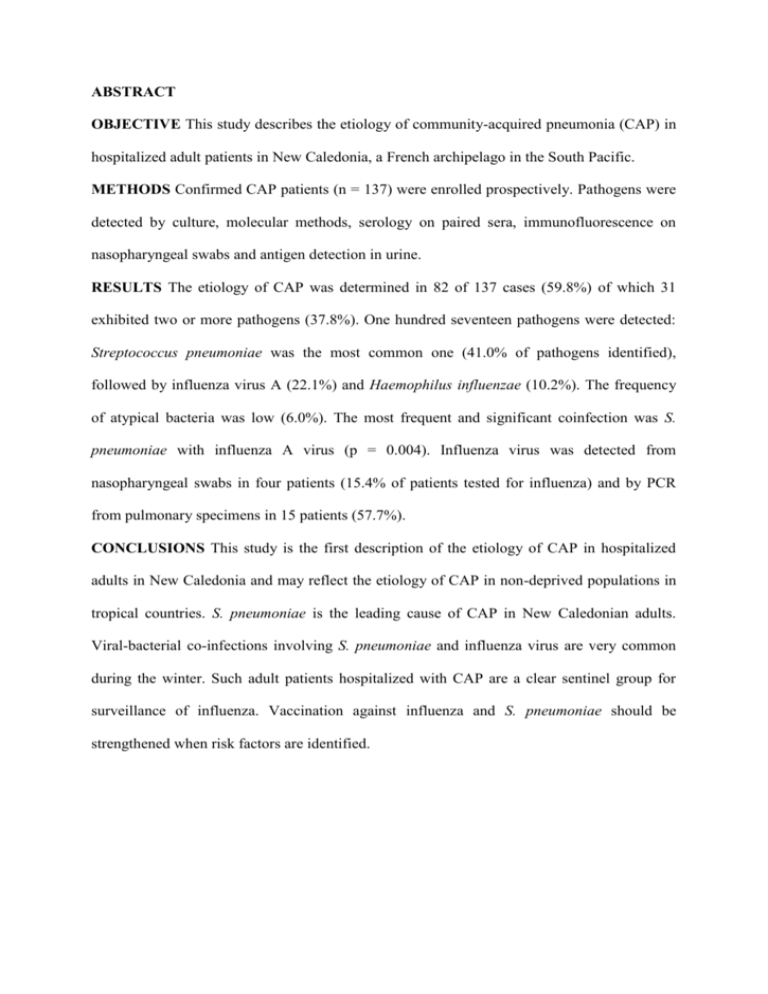
ABSTRACT OBJECTIVE This study describes the etiology of community-acquired pneumonia (CAP) in hospitalized adult patients in New Caledonia, a French archipelago in the South Pacific. METHODS Confirmed CAP patients (n = 137) were enrolled prospectively. Pathogens were detected by culture, molecular methods, serology on paired sera, immunofluorescence on nasopharyngeal swabs and antigen detection in urine. RESULTS The etiology of CAP was determined in 82 of 137 cases (59.8%) of which 31 exhibited two or more pathogens (37.8%). One hundred seventeen pathogens were detected: Streptococcus pneumoniae was the most common one (41.0% of pathogens identified), followed by influenza virus A (22.1%) and Haemophilus influenzae (10.2%). The frequency of atypical bacteria was low (6.0%). The most frequent and significant coinfection was S. pneumoniae with influenza A virus (p = 0.004). Influenza virus was detected from nasopharyngeal swabs in four patients (15.4% of patients tested for influenza) and by PCR from pulmonary specimens in 15 patients (57.7%). CONCLUSIONS This study is the first description of the etiology of CAP in hospitalized adults in New Caledonia and may reflect the etiology of CAP in non-deprived populations in tropical countries. S. pneumoniae is the leading cause of CAP in New Caledonian adults. Viral-bacterial co-infections involving S. pneumoniae and influenza virus are very common during the winter. Such adult patients hospitalized with CAP are a clear sentinel group for surveillance of influenza. Vaccination against influenza and S. pneumoniae should be strengthened when risk factors are identified. Etiology of community-acquired pneumonia in hospitalized adult patients in New Caledonia Sylvain Mermond1, Alain Berlioz-Arthaud1, Maurice Estivals2, Francine Baumann1, Hervé Levenes2, and Paul M. V. Martin1 1 Institut Pasteur de Nouvelle-Calédonie, Nouméa, New Caledonia 2 Service de Pneumologie, CHT Gaston Bourret, Nouméa, New Caledonia Corresponding Author Sylvain Mermond, Institut Pasteur de Nouvelle-Calédonie, BP 61, 98845 Nouméa Cedex, New Caledonia. Tel.: +687 272666; E-mail: smermond@pasteur.nc Word count: 3501 Introduction Community-acquired pneumonia (CAP) is an important cause of hospitalization and death worldwide (Garau & Calbo 2008). Antimicrobial treatment must be prompt but is often given in the absence of, or before, microbiological investigations, based on specific guidelines adapted to local microbial patterns (Woodhead et al. 2005; Macfarlane & Boldy 2004; Mandell et al. 2007). New Caledonia is a French archipelago in the South Pacific. Its population is approximately 230,800 people (2004 census) divided in different ethnic groups: Melanesians (44%), Europeans (34%), Wallisians (9%), Tahitians (2.6%), Indonesians (2.5%) and others (7.9%). The climate is tropical and oceanic with two marked seasons: a warm and wet season from December to March and a cooler one from June to September. Patients with respiratory infections are usually referred to the Territory Hospital in Noumea hosting intensive care unit facilities and specialist chest physicians. Everyone have access to the health care system. There has been no comprehensive study of the etiology of CAP in New Caledonia; diseases management is based on French guidelines (AFSSAPS 2005). However, locally-developed treatment guidelines have been effective in some countries of the Pacific region (Elliott et al. 2005). Moreover, specific etiologies have been reported in New Caledonia (Burkholderia pseudomallei, Histoplasma capsulatum) which could be taken into account to establish treatment guidelines (Estivals et al. 2008; Noel et al. 1995). We conducted a prospective study over a one year period in adult patients hospitalized in New Caledonia main hospital to (i) determine the etiology of CAP, (ii) evaluate the performances of locally available laboratory tests and (iii) assess the vaccination preventable proportion of causative agents, with a special focus on Streptococcus pneumoniae and influenza. Methods Study design Adult patients, aged 16 years or older, admitted to the Territory Hospital with suspected CAP (n = 173) were evaluated prospectively between December 2006 and November 2007. We used the following criteria for confirmation of CAP: presence of lower respiratory tract infection symptoms at initial presentation or within 48 hours of being hospitalized associated with infiltrates on chest X-ray. Patients with HIV related immunosuppression, tuberculosis or any other illness causing radiographic abnormalities (lung cancer, for example) were excluded. Eligibility was confirmed for each patient by a senior chest physician. Patients lacking respiratory specimens for microbiological investigations were also excluded. Ethics, patient evaluation, data and sample collection The New Caledonian Health Authorities approved the study protocol and informed consent was obtained from all patients. Patient data were collected using a standardized questionnaire, including pneumococcal and influenza immunization history. Chest X-ray patterns and laboratory results at presentation and during the hospital stay were collected. The two criteria used to assess CAP severity were admission to the intensive care unit (ICU) and the pneumonia severity index (PSI), defining severe disease as risk classes IV and V (Fine et al. 1997). Respiratory tract specimens (sputum, tracheobronchial aspirate – TBA –, bronchoalveolar lavage – BAL – or protected specimen brush – PSB –), two blood cultures and, when indicated pleural fluid, were collected shortly after admission, before starting antibiotherapy. We additionally took paired sera for serology, urine for antigen testing, and nasopharyngeal swabs for virus detection. Microbiological laboratory tests Microbiological tests were carried out on respiratory specimens according to the French Society of Microbiology (SFM) criteria (SFM 2007). Sputum samples were Gram stained and leukocytes and epithelial cells counts recorded per X100 microscopic field. Only good quality specimens (>25 granulocytes and <10 epithelial cells) were retained for analysis (Murray & Washington 1975). Sputum, TBA, BAL, PSB and pleural fluid samples were cultured at 37°C on blood agar with nalidixic acid, chocolate agar and Sabouraud agar (when positive for yeast on Gram stain). Cultures were counted, with results expressed as colony-forming units per millilitre (CFU/mL) and interpreted using the SFM standards. Blood cultures were analyzed with the BacT/ALERT ®3D system (bioMérieux, France). Influenza viruses A and B, parainfluenza virus-3 (PIV-3) and adenovirus (ADV) were detected from nasopharyngeal swabs by indirect immunofluorescence assay (Monofluo® Kit, Biorad, France) and respiratory syncytial virus (RSV), by direct immunofluorescence assay (Monofluo® Screen, Biorad, France). Legionella pneumophila serotype 1 and Streptococcus pneumoniae antigens were detected in non-concentrated urine using an immunochromatographic assay (Binax NOW®, Binax Inc., USA). PCR assay RNA and DNA from sputum, TBA, BAL or PSB samples were extracted using a single format magnetic silica-based method automated on the EasyMag system (bioMérieux, France). A molecular assay was used for parallel detection of Chlamydophila pneumoniae, Mycoplasma pneumoniae and Legionella spp. Real-time PCR was performed using the LightCycler® 2.0 (Roche Diagnostics, New Zealand) with primers and hybridization probes, as described elsewhere (Raggam et al. 2005). Influenza viruses A and B were detected from respiratory samples by real-time RT-PCR. We used primers and hybridization probes previously described for influenza B virus (Smith et al. 2003). Influenza A virus-specific hybridization probes were used, allowing H1N1 and H3N2 subtypes dicrimination by melting temperature analysis (Stone et al. 2004). Serology Paired sera samples were collected when possible at an optimal interval of three weeks. Antibodies to influenza A and B viruses, ADV, RSV, PIV types 1, 2, and 3 (Virion Institute, Switzerland) were detected by complement-fixation tests. M. pneumoniae IgM antibodies were tested by indirect ELISA (RIDASCREEN®, r-biopharm, Germany). Diagnostic criteria for determination of microbial etiology Etiology was classified as ‘definite’, ‘probable’ or ‘unknown’ following SFM guidelines and published criteria (SFM 2007; Ruiz et al. 1999). It was considered definite when (1) a usual respiratory tract pathogen was cultured from blood or pleural fluid, (2) bacterial growth in quantitative cultures reached > 105 CFU/mL for TBA, > 104 CFU/mL for BAL and > 103 CFU/mL for PSB, (3) the PCR for C. pneumoniae, M. pneumoniae, Legionella spp. or influenza viruses was positive, (4) the urinary antigen test was positive for S. pneumoniae or L. pneumophila, (5) the immunofluorescence assay for respiratory viruses was positive, or (6) when we observed a seroconversion, or four-fold rise in antibody titres for respiratory viruses, a single titre for influenza viruses > 80 or, for M. pneumoniae, a single high IgM titre > 70 UA/mL. Influenza positive serology in patients recently vaccinated - i.e. 12 months or less prior to hospitalization - was not considered, as post infection and vaccine induced antibodies are indistinguishable. The etiology of pneumonia was classified as probable when a valid sputum sample yielded one or two predominant bacterial strains. Statistics Stata SE 8.0 (StataCorp, Texas, USA) was used for all calculation. Continuous variables were compared using the Student’s t test when the theoretical numbers were low. Categorical variables were compared by using the χ2 test or Fisher’s exact test. Poisson regression was used to determine associations among continuous variables. Multivariate analysis was performed using stepwise forward logistic regression. All reported p values are two-tailed. The level of significance was set at 5%. We calculated odds ratios (OR) and 95% confidence intervals (95% CI). Results Patients We enrolled 173 patients in the study, 36 of which were excluded: chest X-ray was normal in 23, eight showed abnormalities without pneumonia, two were suspected of nosocomial pneumonia, and three had no respiratory specimen available. The 137 included patients had a median age of 58 years (16 to 96), a male/female ratio of 1.4 and an ethnic distribution as follows: 77 Melanesian (56.2%), 23 European (16.8%), 23 Wallisian (16.8%), 4 Tahitian (2.9%), and 10 from other minor groups (7.3%). There was no significant association between ethnic groups and any comorbid condition (table 1), although some factors were observed more frequently in Wallisian patients: current cigarette smoker (60.9%), pulmonary disease (34.8%), and diabetes mellitus (26.1%). Immunization rates against seasonal influenza and S.pneumoniae are summarized in figure 1. Twenty-four patients (17.5%) were treated with antibiotics (at least one beta-lactam) prior to hospitalization. CAP patients main characteristics Twenty-two patients (16.0%) were admitted to the ICU (table 1). These patients, 17 male and 5 female, had a median age of 62 years (37-81). The rate of ICU admission did not differ significantly between ethnic or age groups. Fifty-one patients (37.2%) had a PSI < III, 36 of which (70.5%) were hospitalized for reasons other than pneumonia severity. Length of hospital stay ranged from 1 to 65 days, with a median of 8 days. Mortality rate was 5.8% (8/137). Microbiological investigations Bacteriology Only 59 of the 127 sputum samples collected (46.4%) were considered to be of good quality. Blood culture was positive in 20 patients. In 4 cases, it was the only positive test; the others were also positive for at least another technique (S. pneumoniae urinary antigen test, n = 12; positive culture from a respiratory specimen, n = 6). Pleural fluid analysis detected one isolate of Staphylococcus aureus. Urinary antigen detection was positive for S. pneumoniae in 40 of 133 patients (30%) and the diagnosis rate of pneumococcal CAP was increased by a factor of 2.1 using this test systematically; no urinary samples were tested positive for L. pneumophila serotype 1. C. pneumoniae PCR assays were performed for 132 patients, yielding one positive result. M. pneumoniae IgM were detected for 6 of 136 patients tested. Virology Immunofluorescence assays were positive for five patients (influenza virus A, n = 4; PIV-3, n = 1). Paired sera were obtained for only 34 of 137 patients. For this small subset of patients, 22 were positive for ADV (n = 1), PIV-3 (n = 1), influenza virus A (n = 16), influenza virus A + RSV (n = 1) and possible persistent antibodies against influenza vaccine antigens (n = 3). Diagnosis rates of the different techniques for influenza virus detection are shown in figure 2. CAP etiologies According to our case classification, etiology could be established for 82 of 137 patients (59.8%), considered definite in 47 (34.3%), probable in 35 (25.5%) and therefore unknown in 55 (40.2%) patients. Of the 117 pathogens identified (table 2), 11 viruses and 40 bacteria were identified as single cause of the CAP. Viral-bacterial co-infections accounted for 13.1% of CAP (n = 18) while mixed bacterial and mixed viral infections accounted for 9.5% (n = 13) and 0% of CAP respectively (tables 3 and 4). S. pneumoniae was the most common pathogen; it was present in about one third of patients studied (48/137), representing 41.0% of identified pathogens (48/117) and 74.2% of coinfections and mixed infections (23/31). Serotypes of S. pneumoniae responsible for adults CAP in New Caledonia and concordance with pneumococcal vaccines are shown in figure 3. Ranking 2 was influenza virus A (22.1%), followed by Haemophilus influenzae (10.2%), Moraxella catarrhalis (5.1%), M. pneumoniae (5.1%), Klebsiella pneumoniae (4.2%), and S. aureus (3.5%). The most frequent (n = 11) and significant coinfection was S. pneumoniae associated with influenza A virus (p = 0.004). Of the eight patients who died, the causative agent was identified in five: Escherichia coli + K. pneumoniae, n = 1; K. pneumoniae, n = 2; S. pneumoniae, n = 1; S. pneumoniae + influenza virus A, n = 1. We noticed a particularly high incidence of Gram-negative enteric bacilli bacteremia (K. pneumoniae = 3) in this group but there was no significant association with CAP severity (p = 0.067) or suspicion of aspiration pneumonia. Epidemiological patterns CAP due to S. pneumoniae (n = 48) occurred more frequently in patients aged < 45 years (p = 0.04), with no significant difference between ethnic groups. There was no significant association between ethnicity or comorbidity and etiology of CAP. S. pneumoniae was the most frequent pathogen isolated in patients admitted to ICU (9/22). However, its frequency in this subgroup was similar to that observed for the whole population studied (40.9% and 41.0% respectively). K. pneumoniae was the most frequent agent detected in fatal CAP, but the association between this bacterium and ICU admission was not significant (p = 0.067). There was no relationship between viral-bacterial co-infections and ICU admission neither with a PSI > III. Incidence of CAP was significantly higher during southern winter (p = 0.007). This increased incidence was associated with epidemic seasonal influenza observed during the same period in the general population (p = 0.002; figure 4). Multivariate analysis only showed a significant association between influenza-associated CAP and southern winter (p = 0.03). Discussion This is the first study of CAP etiology in New Caledonia. Etiology was attributed in 59.8% of cases, similar to published data (Jennings et al. 2008). S. pneumoniae urinary antigen testing provided a good alternative to tests involving more invasive means of sample collection. Indeed, the increase in diagnosis rate was consistent with a previous study using further tests such as lung aspirate analysis after transthoracic needle aspiration (Ruiz-Gonzalez et al. 1999). Viruses were identified in 29 of 137 patients with CAP (21.1%) of which 11 were monomicrobic (8.0%) and 18 associated with bacteria. Influenza viruses accounted for 86.6% of viruses in our patients, whereas they accounted for 64.0% of viruses detected in a similar group of patients in Spain in 2004 (de Roux et al. 2004). In New Caledonia, the influenza sentinel network was set up in 1999, including paediatric hospital wards, public and private community GPs. The case definition was based on conventional influenza like illness (ILI) (Berlioz-Arthaud & Barr 2005). Our group of patients is clearly a relevant sentinel group for influenza surveillance: the seasonality of CAP in adults follows this of influenza as evidenced by the surveillance network, suggesting the role of influenza as leading or associated cause of hospitalized CAPs (figure 4). Moreover, in adult patients, influenza surveillance may be more specific than in children where other viruses can induce differential diagnosis. Our results show the benefit of using molecular techniques on pulmonary specimens, e.g. sputum, for the rapid diagnosis of influenza infection in adults: PCR yielded 15 positive results and was the only test to detect infection in approximately one quarter of positive patients (7/26). Immunofluorescence analysis of nasopharyngeal swab smears was positive in only four of 134 patients. By contrast, this test shows high sensitivity in children. Hospitalization of adult patients probably occurred late after onset of symptoms, when influenza viral load in the upper respiratory tract was low or undetectable. Influenza viral infections were mixed in 65.4% of our patients; associated bacterial infection may be due to superinfection. Peltola et al. showed that the neuraminidase activity of influenza viruses correlated with their capacity to promote secondary bacterial pneumonia. Based on these observations, a high level of neuraminidase activity may explain the particularly strong and significant association between influenza A/H3N2 virus and S. pneumoniae in our study, leading to death in two cases (Peltola et al. 2005; Wagner et al. 2000). The weak immunization rate in our patients (7.3%), may lead to strengthen annual influenza immunization campaigns among New Caledonian risk groups i.e. elderly and chronically ill patients. The rate of atypical pathogens was very low (6.0%), possibly explained by our inclusion criteria (hospitalization), the severity of CAP (for 58.4% of the patients, PSI was ≥ III) and the older age of the study population. According to European data, the frequency of M. pneumoniae usually rose as illness severity decreased (Woodhead 2002). M. pneumoniae IgM were detected in 6 patients not exhibiting a positive PCR. Different situations can explain this discordance: false positive IgM results (detection of non specific antibodies), residual IgM in patients with a past M. pneumoniae infection, or failure to detect M. pneumoniae DNA (PCR inhibition, poor quality of the respiratory sample). Sputum has been previously described as specimen of choice for detection of M. pneumoniae, giving 70% concordance with IgM serology, whereas only 40 to 50% concordance is observed for other specimens (DorigoZetsma et al. 2001). We used PCR assays to test for C. pneumoniae. Most other studies use serology tests therefore making it difficult to compare our results with others. Legionella infection usually represents 2 - 5% of CAP, correlating with severity (Woodhead 2002). However, despite using two different sensitive and specific methods, we did not identify Legionella infection in our study population. Studies in Australia and New Zealand have shown L. longbeachae to account for 30.4% of cases of culture-confirmed communityacquired legionellosis (Yu et al. 2002). Urinary antigen detection tests should therefore be used and interpreted with caution in the South Pacific, as only detecting L. pneumophila serotype 1. In New Caledonia, despite differences in traditional medicine, way of life and socioeconomical criteria, we did not find any differences in CAP etiology or severity between ethnic groups. However, S. pneumoniae accounted for 41% of CAP in Melanesians under 45 years old but only 26% of Melanesian CAP patients over 45 years old. This difference is not significant but it may be of interest to investigate age stratification in a larger study group. Analysis of S. pneumoniae capsular serotypes showed that 79% of strains responsible for CAP could be targeted with the 23-valent pneumococcal polysaccharide vaccine, highlighting the importance of pneumococcal vaccination in adults. The current 7-valent pneumococcal conjugate vaccine used in New Caledonia since 2004 is obviously poorly effective on the strains involved in adults CAPs (serotype concordance of 10% only between CAP in New Caledonian adults and vaccine); however, we hope a better indirect (herd) protection in the future with the 13-valent conjugate vaccine since concordance will reach 73% with this new vaccine. References Agence Française de Sécurité Sanitaire des Produits de Santé - AFSSAPS - (2005) Antibiothérapie par voie générale en pratique courante dans les infections respiratoires basses. Principaux messages des recommandations de bonne pratique. http://www.afssaps.fr/var/afssaps_site/storage/original/application/6abe40a8682c0c52429a94 509fe7086a.pdf (accessed 15 March 2010). Berlioz-Arthaud A & Barr IG (2005) Laboratory-based influenza surveillance in New Caledonia, 1999-2003. Trans R Soc Trop Med Hyg. 99, 290-300. Dorigo-Zetsma JW, Verkooyen RP, van Helden HP, van der Nat H, van den Bosch JM (2001) Molecular detection of Mycoplasma pneumoniae in adults with community-acquired pneumonia requiring hospitalization. Journal of Clinical Microbiology 39, 1184-1186. Elliott JH, Anstey NM, Jacups SP, Fisher DA, Currie BJ (2005) Community-acquired pneumonia in northern Australia: low mortality in a tropical region using locally-developed treatment guidelines. International Journal of Infectious Diseases 9, 15-20. Estivals M, du Couedic L, Lacassin F, Mermond S, Levenes H (2008) [Septicemia, bilateral community acquired pneumonia and empyema due to Burkholderia pseudomallei (mellioidosis) with a favorable outcome following prolonged specific antibiotic therapy]. Revue des Maladies Respiratoires 25, 1-4. Fine MJ, Auble TE, Yealy DM, Hanusa BH et al. (1997) A prediction rule to identify lowrisk patients with community-acquired pneumonia. The New England Journal of Medicine 336, 243-250. Garau J & Calbo E (2008) Community-acquired pneumonia. Lancet 371, 455-458. Jennings LC, Anderson TP, Beynon KA et al. (2008) Incidence and characteristics of viral community-acquired pneumonia in adults. Thorax 63, 42-48. Macfarlane JT & Boldy D (2004) 2004 update of BTS pneumonia guidelines: what’s new? Thorax 59, 364-366. Mandell LA, Wunderink RG, Anzueto A et al. (2007) Infectious Diseases Society of America/American Thoracic Society Consensus Guidelines on the Management of Community-Acquired Pneumonia in Adults. Clinical Infectious Diseases 44, S27-72. Murray PR & Washington JA (1975) Microscopic and baceriologic analysis of expectorated sputum. Mayo Clinic Proceedings 50, 339-344. Noel M, Levenes H, Duval P, Barbe C, Ramognino P, Verhaegen F (1995) [Report of acute pulmonary histoplasmosis after visiting a cave in New Caledonia]. Santé 5, 219-225. Peltola VT, Murti KG, McCullers JA (2005) Influenza virus neuraminidase contributes to secondary bacterial pneumonia. The Journal of Infectious Diseases 192, 249-257. Raggam RB, Leitner E, Berg J, Muhlbauer G, Marth E, Kessler HH (2005) Single-run, parallel detection of DNA from three pneumonia-producing bacteria by real-time polymerase chain reaction. The Journal of Molecular Diagnostics 7, 133-138. de Roux A, Marcos MA, Garcia E et al. (2004) Viral community-acquired pneumonia in nonimmunocompromised adults. Chest 125, 1343-1351. Ruiz M, Ewig S, Marcos MA et al. (1999) Etiology of community-acquired pneumonia: impact of age, comorbidity, and severity. American Journal of Respiratory and Critical Care Medicine 160, 397-405. Ruiz-Gonzalez A, Falguera M, Nogues A, Rubio-Caballero M (1999) Is Streptococcus pneumoniae the leading cause of pneumonia of unknown etiology? A microbiologic study of lung aspirates in consecutive patients with community-acquired pneumonia. The American Journal of Medicine 106, 385-390. Smith AB, Mock V, Melear R, Colarusso P, Willis DE (2003) Rapid detection of influenza a and b viruses in clinical specimens by Light Cycler real time RT-PCR. Journal of Clinical Virology 28, 51-58. Société Française de Microbiologie - SFM - (2007) Examen cytobactériologique des sécretions bronchopulmonaires. In Rémic: Vivactis Plus Ed, 31-34. Stone B, Burrows J, Schepetiuk S et al. (2004) Rapid detection and simultaneous subtype differentiation of influenza a viruses by real time PCR. Journal of Virological Methods 117, 103-112. Wagner R, Wolff T, Herwig A, Pleschka S, Klenk HD (2000) Interdependence of hemagglutinin glycosylation and neuraminidase as regulators of influenza virus growth: a study by reverse genetics. Journal of Virology 74, 6316-6323. Woodhead M (2002) Community-acquired pneumonia in Europe: causative pathogens and resistance patterns. The European Respiratory Journal 36, S20-27. Woodhead M, Blasi F, Ewig S et al. (2005) Guidelines for the management of adult lower respiratory tract infections. The European Respiratory Journal 26, 1138-1180. Yu VL, Plouffe JF, Pastoris MC et al. (2002) Distribution of legionella species and serogroups isolated by culture in patients with sporadic community-acquired legionellosis: an international collaborative survey. The Journal of Infectious Diseases 186, 127-128. Table 1 Main characteristics in 137 patients hospitalized with CAP in New Caledonia Comorbid conditions Ethnic group (n) Melanesian (77) European (23) Wallisian (23) Tahitian (4) Other ethnic group (10) Total (137) Sex ratio M/F ICU admission n (%) Mortality rate % (n) 39/38 10 (13.0) 13/10 Cardiovascular disease n (%) Pulmonary disease n (%) Renal disease n (%) Diabetes mellitus n (%) Malignancy n (%) Alcoholism n (%) Current cigarette smoker n (%) ID n (%) Other n (%) 6.5 (5) 19 (24.7) 22 (28.6) 4 (5.2) 7 (9.1) 6 (7.8) 8 (10.4) 31 (40.2) 0 1 (1.3) 6 (26.1) 8.7 (2) 7 (30.4) 6 (26.1) 0 3 (13.0) 2 (8.7) 3 (13.0) 13 (56.5) 1 (4.3) 0 15/8 2 (8.7) 4.3 (1) 3 (13.0) 8 (34.8) 0 6 (26.1) 0 0 14 (60.9) 0 0 3/1 0 0 1 (25.0) 1 (25.0) 0 0 0 1 (25.0) 1 (25.0) 0 0 10/0 4 (40.0) 0 3 (30.0) 4 (40.0) 0 3 (30.0) 2 (20.0) 2 (20.0) 3 (30.0) 2 (20.0) 0 80/57 22 (16.0) 5.8 (8) 33 (24.1) 41 (29.9) 4 (2.9) 19 (13.9) 10 (7.3) 14 (10.2) 62 (45.2) 3 (2.2) 1 (0.7) ICU, intensive care unit; ID, mmunodepression. Table 2 Etiology of CAP in hospitalized adult patients in New Caledonia Pathogens S. pneumoniae (Sp) Classical bacteria (non Sp) - H. influenzae - M. catarrhalis - S. aureus Atypical bacteria - M. pneumoniae - C. pneumoniae - L. pneumophila Gram negative bacilli + P.aeruginosa - E. coli - K. pneumoniae - E. cloacae - P. aeruginosa Viruses - Influenza A - Influenza B - Para-influenza 3 - Adenovirus - RSV Number of pathogens Number of patients Single etiology CAP n (%) 25 (49.0) Viral-bacterial co-infections n (%) 12 (30.7) Mixed bacterial infections n (%) 11 (40.7) Mixed viral infections n (%) NA CAP etiologies definite / probable / unknown n/n/n 42 / 6 / NA 9 (17.6) 4 (10.0) 9 (33.3) NA 3 / 19 / NA 5 (9.8) 2 (3.9) 2 (3.9) 1 (1.9) 1 (1.9) ― ― 1 (2.5) 1 (2.5) 2 (5.0) 2 (5.0) 2 (5.0) ― ― 6 (22.2) 3 (11.1) ― 4 (14.8) 3 (11.1) 1 (3.7) ― NA NA NA NA NA NA NA 0 / 12 / NA 1 / 5 / NA 2 / 2 / NA 7 / 0 / NA 6 / 0 / NA 1 / 0 / NA ― 5 (9.8) 2 (5.0) 3 (11.1) NA 5 / 5 / NA 1 (1.9) 3 (6.0) ― 1 (1.9) 11 (21.5) 9 (17.6) ― 2 (3.9) ― ― 51 (100) 51 ― 1 (2.5) 1 (2.5) ― 19 (48.6) 17 (43.6) ― ― 1 (2.5) 1 (2.5) 39 (100) 18 1 (3.7) 1 (3.7) ― 1 (3.7) NA NA NA NA NA NA 27 (100) 13 NA NA NA NA 0 ― ― ― ― ― 0 0 1 / 1 / NA 3 / 2 / NA 0 / 1 / NA 1 / 1 / NA 30 / 0 / NA 26 / 0 / NA ― 2 / 0 / NA 1 / 0 / NA 1 / 0 / NA 87 / 30 / NA 47 / 35 / 55 RSV, respiratory syncytial virus; NA, not applicable. Table 3 Mixed bacterial infections responsible for CAP in New Caledonia Mixed bacterial infections responsible for CAP Streptococcus pneumoniae plus: - Haemophilus influenzae - Haemophilus influenzae and Chlamydophila pneumoniae - Mycoplasma pneumoniae - Moraxella catarrhalis - Pseudomonas aeruginosa Escherichia coli and Klebsiella pneumoniae Moraxella catarrhalis and Mycoplasma pneumoniae Total n 5 1 2 2 1 1 1 13 Table 4 Viral-bacterial co-infections responsible for CAP in New Caledonia Viral-bacterial co-infections responsible for CAP Streptococcus pneumoniae plus: - Influenza virus A - Influenza virus A and Mycoplasma pneumoniae - Adenovirus Influenza virus A plus: - Staphylococcus aureus and Klebsiella pneumoniae - Staphylococcus aureus and respiratory syncytial virus - Haemophilus influenzae - Mycoplasma pneumoniae - Moraxella catarrhalis - Enterobacter cloacae Total n 10 1 1 1 1 1 1 1 1 18 Figure 1 Immunization rates against seasonal influenza and S. pneumoniae (23-valent pneumococcal polysaccharide vaccine) Seasonal influenza vaccine Pneumococcal vaccine 60 51,8 46 50 46,7 47,4 % 40 30 20 10 7,3 0,7 0 Vaccinated Unvaccinated Unkown Figure 2 Diagnosis rate of the different techniques used to detect influenza virus IF only 2; 7,7% 1; 3,8% PCR only 7; 26,9% 5; 19,2% Serology only IF and PCR 1; 3,8% PCR and serology 10; 38,5% IF and PCR and serology IF, immunofluorescence; PCR, polymerase chain reaction. Figure 3 Serotypes of S. pneumoniae responsible for adults CAP in New Caledonia and concordance with anti-pneumococcal vaccines 7 PCV13 PPV23 6 5 PCV13 PCV13 4 n PPV23 PPV23 PCV7 3 PCV13 2 PPV23 PPV23 4 10A 1 0 7F Nontypable 1 3 16F 35B Serotypes 7-valent pneumococcal conjugate vaccine (PCV7): 4, 6B, 9V, 14, 18C, 19F, 23F 13-valent pneumococcal conjugate vaccine (PCV13): 1, 3, 4, 5, 6A, 6B, 7F, 9V, 14, 18C, 19A, 19F, 23F 23-valent pneumococcal polysaccharide vaccine (PPV23): 1, 2, 3, 4, 5, 6B, 7F, 8, 9N, 9V, 10A, 11A, 12F, 14, 15B, 17F, 18C, 19A, 19F, 20, 22F, 23F, 33F Figure 4 Seasonal distribution of CAP in New Caledonia 70 New Caledonia influenza surveillance network 25 Influenza positive cases in the study Patients included in the study 20 50 15 40 30 10 20 5 10 AR AP R M AY JU N JU L AU G SE P NO OC T V 20 07 FE B 0 M DE C 20 06 JA N 0 Number of patients in the study. Influenza cases (surveillance network). 60
